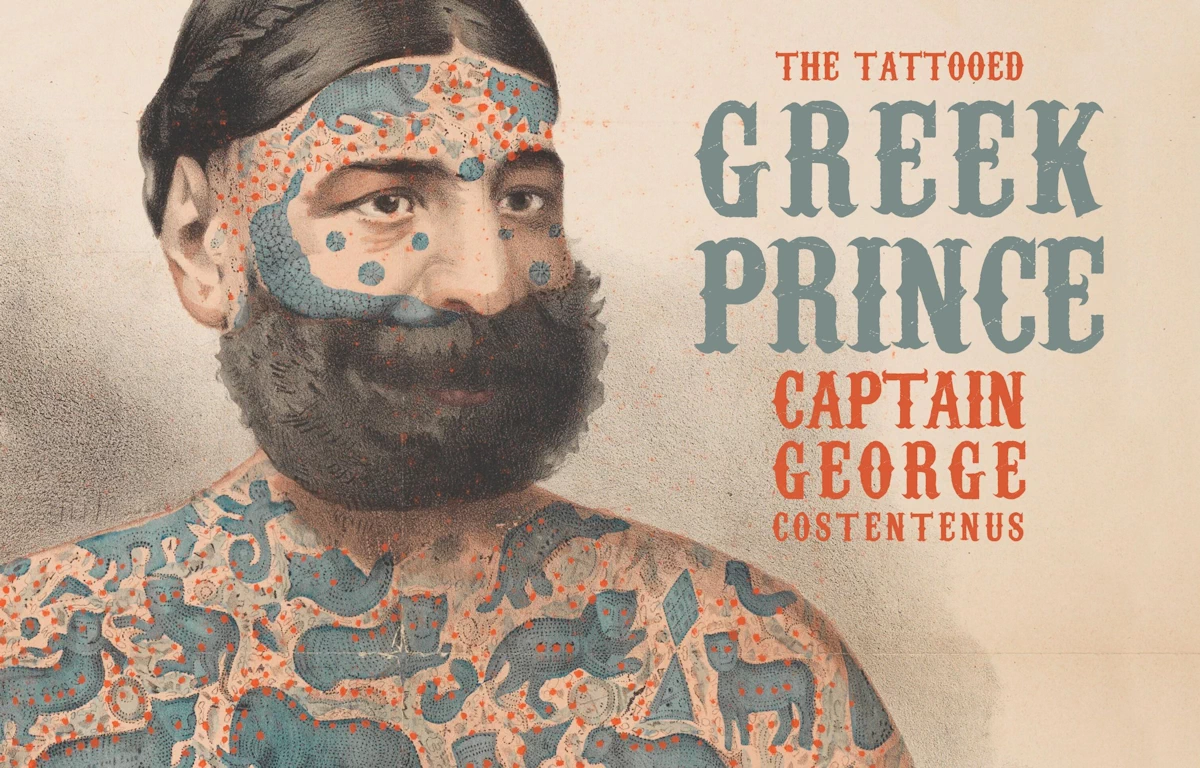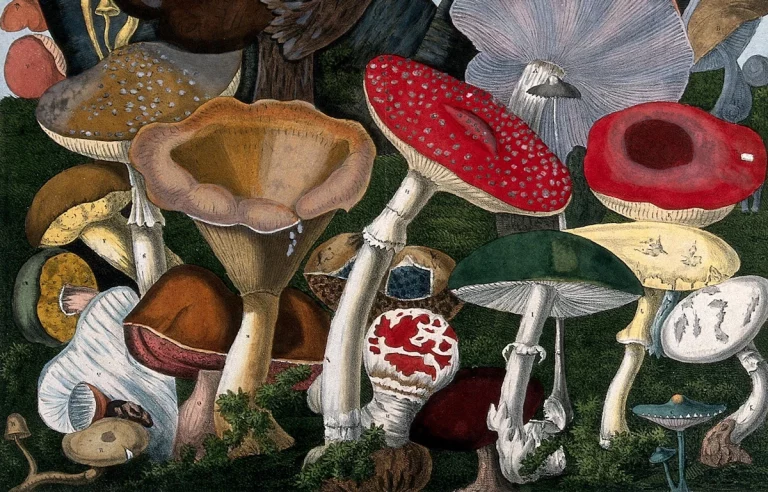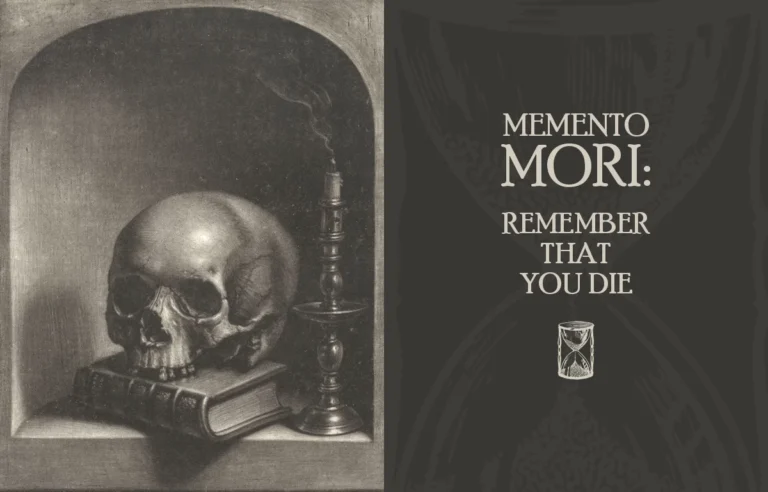The Extraordinary Life of Captain George Costentenus: The Tattooed Greek Prince
Imagine a world where adventure, mystery, and a human canvas covered in ink collide. No, it’s not the premise of a new Netflix series—it’s the real-life saga of Captain George Costentenus, better known as “The Tattooed Greek Prince.” His life in the 19th century was a whirlwind of myth, mystery, and circus magic, making him one of the most fascinating sideshow performers of his time. From a mysterious past to a career in the circus, Costentenus lived a life that was anything but ordinary.
A Prince with a Mysterious Past
Born Djordgi Konstantinus in 1833, Costentenus was of Greek descent and hailed from a region in the Ottoman Empire that today is part of Albania. But when it comes to his early life, things get a little… mysterious. According to Costentenus himself, his childhood was like something straight out of a melodramatic soap opera. He claimed that his mother was forced into servitude in a Turkish pasha’s harem, and in a dramatic twist, his father shot her to save her from this life. Young George was then supposedly raised in the harem, given the name Fatima, and dressed as a girl.
While this story sounds like a wild tale (and probably is), a few verifiable facts do exist. For instance, Costentenus was incredibly intelligent, speaking eight languages fluently—Arabic, English, French, German, Greek, Italian, Persian, and Spanish. Being this much of a polyglot suggests he had a pretty well-rounded education, hinting that the adventurer we know might have had a more privileged upbringing than he let on. His linguistic prowess wasn’t just a party trick; it hinted at a life rich in diverse cultural experiences, which would later play into his success as a performer.
Pirate, Adventurer, and… Human Canvas?
Costentenus didn’t spend his early life lounging in luxury, though. He had a wild streak and an adventurer’s heart, eager to explore and take risks. In 1867, he joined an expedition of twelve men searching for gold in what is now Myanmar (then known as Burma). This would prove to be a life-altering decision, though not in the way he hoped. Instead of striking gold, the expedition was captured by the Burmese Royal Army.
What happened next would leave a permanent mark—literally. The Burmese soldiers executed nine of the twelve men, sparing only Costentenus and two others. Their punishment? Full-body tattooing using indigo and cinnabar, a toxic mercury compound. These tattoos weren’t just for show; they were intended as marks of disgrace, branding the men for their supposed crimes.
Costentenus was tattooed from head to toe, with 388 intricate designs covering his body. These included animals, geometric shapes, Burmese writing, and floral patterns. No part of his body was spared—not even his eyelids, ears, or more sensitive areas. Ouch. To top it off, the writing between his fingers branded him as a person of poor character. If that’s not the ultimate permanent insult, I don’t know what is.
The process was excruciating and dangerous. Costentenus’ two companions didn’t survive the ordeal, making his survival even more remarkable. But how he escaped is yet another mystery. Some say he fled with a fellow captive Spaniard, while others suggest he was eventually released. Either way, Costentenus made it out alive—and inked forever. What’s even more fascinating is that Costentenus’ tattoos were not just marks of punishment but also intricate pieces of art that would captivate audiences and experts alike for years to come.
From Survivor to Sensation
After his escape, Costentenus returned to Europe, where his tattooed body became the talk of the town. Scientists, doctors, and anthropologists were fascinated by his tattoos and the story behind them. Though some questioned the truth of his wild tales, no one could deny the authenticity of his Burmese body art.
Seeing an opportunity, Costentenus began to exhibit himself in shows across Europe. By 1875, his fame had grown so much that he traveled to the United States for the Centennial Exposition, the first World’s Fair held in America. This was where his life took another dramatic turn. His arrival in America was not just a career move; it was a transformation from an exile to a global sensation. The Centennial Exposition was a massive event, showcasing the latest innovations and exotic wonders from around the world, and Costentenus was the perfect blend of both.
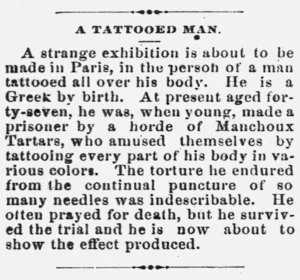
Joining the Greatest Show on Earth
During the exposition, Costentenus caught the eye of none other than P.T. Barnum, the master of showmanship himself. Barnum, always on the lookout for unique attractions, immediately saw the potential in Costentenus. The Tattooed Greek Prince soon became one of the top acts in Barnum’s “New and Greatest Show on Earth.”
Costentenus became a headliner, earning $100 a day—a huge sum at the time. Audiences were captivated by his incredible tattoos, and his equally incredible story kept them coming back for more. Barnum’s posters billed him as the “Living Tattooed Man” and “The Tattooed Greek Prince,” playing up the exoticism and mystery that surrounded Costentenus.
Barnum’s flair for the dramatic helped Costentenus become an international star. He toured all over the United States and Europe, mesmerizing crowds with his story of survival and transformation. Whether or not people believed every detail of his tale didn’t matter—his tattoos were real, and that was enough to keep audiences hooked. The partnership between Costentenus and Barnum was a match made in entertainment heaven, blending spectacle with storytelling in a way that would inspire future performers.
The Power of Tattoos
In the 19th century, tattoos were still a rare sight, especially in Europe and America. For most people, they were associated with sailors or criminals. But Costentenus helped change the public perception of tattoos. His intricate designs weren’t just art—they were a living story, a symbol of adventure, survival, and even rebellion.
Medical professionals and anthropologists were especially intrigued by his tattoos. In an era when body art was still considered exotic, Costentenus became a subject of study, with experts analyzing the meanings behind his tattoos and the cultural significance of his body as a human canvas. His tattoos provided a rare glimpse into Burmese culture and the harsh realities faced by those marked by it, making him a living artifact of an ancient tradition.
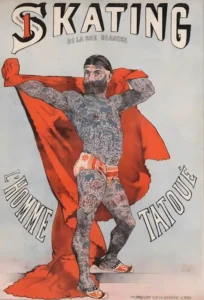
Settling in America
In 1882, Costentenus settled in New York City, and a year later, he officially became an American citizen. For the next decade, he continued to tour and perform, living comfortably on the fortune he’d earned from his circus career. His fame even led to his inclusion in Madame Tussaud’s Wax Museum in London—a sure sign that he’d achieved superstar status in the world of sideshow performers.
But then, in the mid-1890s, Costentenus disappeared from the public eye. His final performance was in 1894, and after that, no one seems to know what became of him. Did he retire quietly? Did he return to Europe for more adventures? Or did he simply vanish into thin air, leaving behind only the legend of the Tattooed Greek Prince? The mystery surrounding his disappearance adds another layer to his already enigmatic persona, fueling speculation and intrigue among historians and fans alike.
The Legacy of Captain George Costentenus
Captain George Costentenus didn’t just leave behind a body covered in tattoos—he left behind a legacy that still fascinates and inspires people today. His life was a blend of myth, mystery, and spectacle, capturing the imaginations of those who heard his story or saw him perform.
Costentenus was more than just a tattooed man—he was a symbol of survival, resilience, and the power of storytelling. Whether every detail of his life was true or embellished doesn’t matter. What matters is that he blurred the line between fact and fiction, creating a persona that was larger than life. His story demonstrates how the extraordinary can be shaped by both reality and imagination, highlighting the enduring appeal of larger-than-life characters.
Even today, the image of the tattooed man has evolved, with Costentenus often regarded as one of the earliest pioneers in the world of body art. His story continues to inspire tattoo enthusiasts and artists, showing how tattoos can be more than just decorations—they can tell stories, capture history, and represent personal journeys. Costentenus’ life is a testament to the power of transformation and the ways in which personal struggles and achievements can leave a lasting impact on cultural history.
A Life of Adventure, Mystery, and Art
The story of Captain George Costentenus is the stuff of legend. From his mysterious origins to his daring escape from captivity, to his rise as a sideshow star, his life was filled with enough twists and turns to make any Hollywood screenwriter jealous.
But beyond the circus tents and sideshow banners, Costentenus represents something even bigger: the human fascination with the extraordinary. His life was a celebration of adventure, mystery, and self-expression—things that continue to resonate with us today. In an era where the world feels increasingly small, the story of the Tattooed Greek Prince reminds us of a time when the world was full of untold stories, waiting to be discovered.
Captain George Costentenus may have disappeared from the stage, but his legend lives on, inspiring curiosity, wonder, and a sense of adventure. His life, marked by incredible feats and captivating art, serves as a reminder of the endless possibilities that lie within the human spirit.


